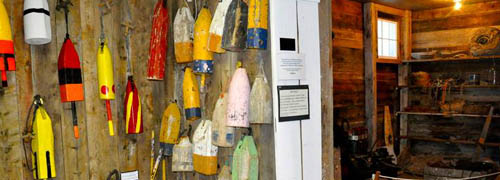 |
|
LOBSTER
TRAP BUOY &
FISHERMEN'S SHED
EXHIBITS
|
The
Fisherman's Shed Exhibit
is a reconstruction of
Snooks Green ( see
diving exhibit)
shed on the Ingalls Head
Road which was partially
reconstructed inside the
Museum in the fall of
2011 with a grant from
the New Brunswick
Heritage Branch, Dept.
Tourism, Heritage and
Culture.
The lobster trap
display traces the
lineage of some of the
lobster trap buoys
still in use today,
using old wooden buoys
from Snooks Green’s
former Ingalls Head
fishing shed.
|
|

Lobster Trap Buoy and
Fisherman's Shed Exhibits. |
|
|
|
About
the Collection:
|
|
Lobster Trap
Buoys: An Island
Genealogy
Lobster licenses are often
passed down through families,
and even when a license is
sold the new owner will
usually adopt the buoy colours
of the former owner.
The trap buoy is the marker
which allows fishermen to
identify and find their set
traps so that they can haul
them up, remove their
lobsters, re-bait them and set
them again. The last
wooden buoys were made in the
1950s and have been replaced
since then with different
styles of synthetic foam
material buoys, having
plastic, rather than wooden,
swivels and stems.
Items on Display:
A wall of historic wooden
buoys; A wall of newly painted
wooden buoys, showing buoy
colours and markings still in
use today and a legend tracing
lineage; Photographs of
lobster traps on wharves, and
of buoys, from c. 1960-1995; A
photograph of the “Lobster
Trap Buoys of Ingalls Head”
quilt patch from the
Bicentennial Quilt (1784-1984)
with legend identifying each
owner of the colours/markings;
and a miniature reproduction
of the same quilt patch, with
decorative wooden buoys
|
|
Fisherman's
Shed
A typical fisherman's shed is
filled with items related to
an often multi-faceted
fishery. Many fishermen
traditionally have set traps
for lobster in the fall, gone
hand-lining for ground fish or
tended herring weirs in the
summer (if they owned shares
in one of the more than 100
that used to surround the
island), and perhaps gill
netted or dragged for scallops
throughout summer and fall as
well.
A typical fisherman’s shed
will be in constant disarray,
filled with hooks, lines and
sinkers, a miscellany of
carpentry tools, warm
clothing, and much, much
more. Here is where they
store their gear, paint their
lobster trap buoys, mend
twine, repair a boat engine,
or build a toy boat for a
grandson. Some sheds
have tubs for gutting or
salting fish, or are used for
shucking scallops or baiting
lobster pockets – whatever the
activity, the aroma is always
interesting!
|
|
| |
|
|
| |
|